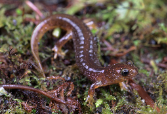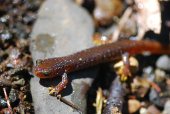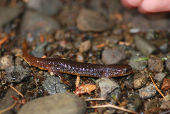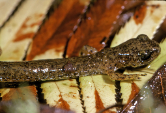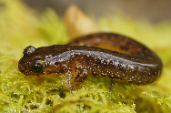Olympic Torrent Salamander (Rhyacotriton olympicus)
Description: The Olympic torrent salamander is a small, aquatic, stream-adapted salamander (less than 2.4 inches snout to vent length). The head is small with a short rounded. The body is relatively long with short limbs and a short tail. Coloration is brown above and yellow to orange-yellow below. White speckling on the body tends to be more concentrated on the sides. This species generally lacks dark dorsal (topside) spotting or blotching, but may have ventral (underside) spotting.
Olympic torrent salamanders have large prominent eyes. The large size of the eyes (eye diameter approximately equal to snout length), relatively short, rounded snout and generally prominent yellow component to the belly color are features that help distinguish torrent salamanders from other Washington salamanders.
Adult male torrent salamanders can be distinguished from all other salamanders by the presence of prominent squared vent lobes, a trait unique to the family and the genus. The color pattern and morphology of torrent salamander species are similar and variable; therefore, torrent salamander species are best identified by collection locality and how that relates to the documented ranges of each species.
Superficially, metamorphosed torrent salamanders resemble woodland salamanders (Plethodon species) and ensatina, but torrent salamanders lack nasolabial grooves and a constriction at the base of the tail (unique to ensatina). Torrent salamanders and rough-skinned newts have a similar color pattern, but differ in overall appearance with newts being stockier, having a thicker skin that is often rough (in the terrestrial phase) and lacking costal grooves. Adult torrent salamanders have very reduced lungs and breathe mostly through their skin.
Habitat: Olympic torrent salamander occur in mature coniferous forests where they inhabit cold, permanent streams, seepages, and waterfall splash zones. Stream segments tend to be shallow and slow flowing, and have gravel or rock rubble with low levels of silt. Olympic torrent salamanders tend to be more abundant in streams with north aspects, steep gradients, and cobble substrates. Spaces between rocks are used for cover.
Occupied streams need to be protected with forested riparian buffers that provide stream shading, near-stream terrestrial ambient moisture regimes, large wood recruitment, and dispersal habitat.
Range: Olympic torrent salamanders are native to the Olympic Peninsula, and distribution within the range is patchy. The species was found to be widespread within Olympic National Park where surveys found it in 41 percent of 168 streams and 47 percent of 235 seeps.
Found in these States:
WA
Diet: They are opportunistic predators on invertebrates.
Reproduction: Olympic torrent salamanders are active year round, and the mating season is probably prolonged. No nests have been found, presumably because eggs are laid in inaccessible recesses in head-water streams and seeps. Clutch number is also unknown, but is likely small (eight or fewer eggs). The incubation and larval periods are long (seven to nine months and more than two years respectively).
Status: Listed as Near Threatened because its extent of occurrence (EOO) is 9,671 km2, it occurs in 10 or fewer threat-defined locations, and the habitat is at risk of future decline in the extent and quality of its habitat due to the consequences of ongoing climate change, thus making the species close to qualifying for Vulnerable. At present, the impacts of climate change and timber harvesting on the population are not fully understood, although preliminary evidence suggests that the species may be experiencing localised declines. Therefore, continued population monitoring is recommended.
»» Kingdom: Animalia - Animals
»» Phylum: Chordata - Chordates
»» Subphylum: Vertebrata - Vertebrates
»» Class: Amphibia - (Amphibians)
»» Order: Caudata - Salamanders
»» Family: Rhyacotritonidae - Torrent Salamanders
»» Genus: Rhyacotriton
»» Species: Rhyacotriton olympicus - Olympic Torrent Salamander
This article uses material from the Wikipedia article "Olympic Torrent Salamander", which is released under the Creative Commons Attribution-Share-Alike License 3.0. Content may have been omitted from the original, but no content has been changed or extended.
|




